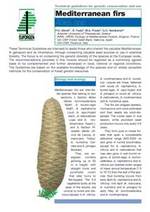Abies spp - Technical guidelines for genetic conservation and use for Mediterranean firs
Due to the threats, endemism and geographically scattered distribution, the conservation of Mediterranean firs and their genetic resources is a major challenge.
The genetic resources of the firs are currently conserved in various protected areas that have rarely been established for this purpose. Due to their evolutionary history and specific adaptation, the fir forests harbour unique genetic resources that are important beyond the Mediterranean. Thus, the establishment of conservation units for the firs that meet pan-European minimum requirements for dynamic gene conservation is of crucial importance.
At present, several of the species and their genetic resources are protected either in situ (national parks, nature reserves and gene conservation units) or ex situ (conservation seed orchards and stands). The critically endangered A. nebrodensis is conserved in situ in the Madonie Regional Park in Sicily, but the reinforcement of the species has been problematic mainly due to soil degradation in its natural habitat. A. nebrodensis is also conserved ex situ in a seed orchard (with grafts of the 29 remaining individuals of the species) in Arezzo, in botanical gardens (40 000 plants in the Botanical Garden of Palermo), arboreta and in private properties in the Madonie Mountains close to the natural habitat. A. borisiiregis and A. cephalonica are protected in situ in various protected areas in Greece. Genetic material, representing almost the whole natural distribution of the fir species, is included in provenance trials established in Greece and France. A. cilicica is protected in national parks, nature reserves and seed stands in ten areas in Turkey and in Lebanon while in Syria it is considered as an endangered species. A. equi-trojani is conserved in situ in the Kazdagi Goknari nature reserve in Turkey. A. nordmanniana is also covered by protected areas in Turkey and several provenances are growing ex situ in test sites, plantations and arboreta in Denmark and France. The A. pinsapo forests are included in three protected areas in Spain. A. numidica is protected in the Djebel Barbor nature reserve located in the Petite Kabylia Mountain range of Algeria and the same provenance is reportedly also conserved in ex situ stands. At present A. marocana is conserved in a nature reserve in Morocco and seven ex situ stands have also been established for the species.
Climate change will have an impact on the current in situ conservation efforts but it is difficult to predict its effect on seed production, natural regeneration and recruitment of the firs as well as on the risks from insects and pathogens. The dynamic gene conservation units should be monitored in order to ensure that the populations are not seriously affected and that they retain their evolutionary potential and regenerate naturally. Management of the units should aim mainly at assisting natural regeneration and when this is not possible, the area should be artificially regenerated with local genetic material. Management of natural forests should also safeguard genetic resources by allowing natural selection to occur on regeneration in a variety of situations. Ex situ conservation efforts should focus on small populations that have an endangered status, insufficient seed production or unsuccessful pollination in their natural environment. This approach is useful especially in case of rare species or species with limited or scattered distribution as ex situ stands with a sufficient number of genotypes form new interbreeding populations that will produce seeds with a potentially high genetic diversity.
Mediterranean firs offers an opportunity to tackle the predicted forest decline in southern Europe as a result of climate change. A. nordmanniana has already been used for reforestation in Europe. Other Mediterranean firs (particularly A. cephalonica, A. bornmuelleriana and A. cilicica) are far less water demanding and could represent an alternative for silver fir (A. alba) in Europe. Fir provenance tests in the Mediterranean include material that has demonstrated good growth, adaptation to drought and late bud burst in spring. Such provenances of Mediterranean firs could be of interest for the European forestry.
Authors: Paraskevi Alizoti; Bruno Fady; Maria Arancha Prada; Giovanni Giuseppe Vendramin
Corporate Author: Bioversity International, Rome (Italy)
Journal/Series:
EUFORGEN Technical Guidelines for Genetic Conservation and Use
Publication Year: 2011
Publication Format: PDF
ISBN 13: 978-92-9043-827-4
Language: EN
Pages: 6 p.
Technical guidelines Abies pinsapo Abies numidica Abies marocana Abies nordmanniana Abies borisii-regis Abies bornmuelleriana Abies cephalonica Abies cilicica Abies equi-trojani Abies nebrodensis

